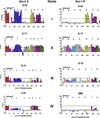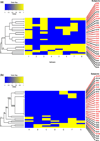Epitope analysis of Ara h 2 and Ara h 6: characteristic patterns of IgE-binding fingerprints among individuals with similar clinical histories
- PMID: 25213872
- PMCID: PMC4470374
- DOI: 10.1111/cea.12407
Epitope analysis of Ara h 2 and Ara h 6: characteristic patterns of IgE-binding fingerprints among individuals with similar clinical histories
Abstract
Background: Ara h 2 and Ara h 6 are moderately homologous and highly potent peanut allergens.
Objective: To identify IgE-binding linear epitopes of Ara h 6, compare them to those of Ara h 2, and to stratify binding based on clinical histories.
Methods: Thirty highly peanut-allergic subjects were stratified by clinical history. Sera were diluted to contain the same amount of anti-peanut IgE. IgE binding to overlapping 20-mer peptides of Ara h 2 and Ara h 6 was assessed using microarrays.
Results: Each subject had a unique IgE-binding fingerprint to peptides; these data were coalesced into epitope binding. IgE from subjects with a history of more severe reactions (n = 19) had a smaller frequency of binding events (BEs) for both Ara h 2 (52 BEs of 152 (19X8epitopes) possible BEs and Ara h 6 (13 BEs of 133 (19X7 epitopes) possible BEs) compared to IgE from those with milder histories (n = 11) (Ara h 2: 47 BEs of 88 (11X8 epitopes) possible BEs, P < 0.01; Ara h 6: 25 BEs of 77 (11X7 epitopes) possible BEs, P < 0.001). Using an unsupervised hierarchal cluster analysis, subjects with similar histories tended to cluster. We have tentatively identified a high-risk pattern of binding to peptides of Ara h 2 and Ara h 6, predominantly in subjects with a history of more severe reactions (OR = 12.6; 95% CI: 2.0-79.5; P < 0.01).
Conclusions and clinical relevance: IgE from patients with more severe clinical histories recognize fewer linear epitopes of Ara h 2 and Ara h 6 than do subjects with milder reactions and bind these epitopes in characteristic patterns. Close examination of IgE binding to epitopes of Ara h 2 and Ara h 6 may have prognostic value.
Keywords: Ara h 2; Ara h 6; IgE; allergens; microarrays; peanut; peptides.
© 2014 John Wiley & Sons Ltd.
Conflict of interest statement
Drs. Dreskin and Otsu have a patent pending based on methodology described in this manuscript. Dr. Guo does not have any conflict of interests to disclose regarding this manuscript.
Figures






Similar articles
-
Conformational IgE epitopes of peanut allergens Ara h 2 and Ara h 6.Clin Exp Allergy. 2016 Aug;46(8):1120-1128. doi: 10.1111/cea.12764. Epub 2016 Jun 27. Clin Exp Allergy. 2016. PMID: 27238146 Free PMC article.
-
Walnut allergy in peanut-allergic patients: significance of sequential epitopes of walnut homologous to linear epitopes of Ara h 1, 2 and 3 in relation to clinical reactivity.Int Arch Allergy Immunol. 2012;157(3):238-45. doi: 10.1159/000327841. Epub 2011 Oct 27. Int Arch Allergy Immunol. 2012. PMID: 22042002 Free PMC article.
-
Allergenicity of peanut component Ara h 2: Contribution of conformational versus linear hydroxyproline-containing epitopes.J Allergy Clin Immunol. 2015 May;135(5):1267-74.e1-8. doi: 10.1016/j.jaci.2014.10.025. Epub 2014 Dec 4. J Allergy Clin Immunol. 2015. PMID: 25483599
-
[Progress of researches on the allergens Ara h 1, Ara h 2 and Ara h 3 from peanut].Sheng Wu Yi Xue Gong Cheng Xue Za Zhi. 2010 Dec;27(6):1401-5. Sheng Wu Yi Xue Gong Cheng Xue Za Zhi. 2010. PMID: 21375004 Review. Chinese.
-
Mono-sensitisation to peanut component Ara h 6: a case series of five children and literature review.Eur J Pediatr. 2016 Sep;175(9):1227-1234. doi: 10.1007/s00431-016-2733-7. Epub 2016 May 20. Eur J Pediatr. 2016. PMID: 27206507 Free PMC article. Review.
Cited by
-
Designer covalent heterobivalent inhibitors prevent IgE-dependent responses to peanut allergen.Proc Natl Acad Sci U S A. 2019 Apr 30;116(18):8966-8974. doi: 10.1073/pnas.1820417116. Epub 2019 Apr 8. Proc Natl Acad Sci U S A. 2019. PMID: 30962381 Free PMC article.
-
Determination of Crucial Immunogenic Epitopes in Major Peanut Allergy Protein, Ara h2, via Novel Nanoallergen Platform.Sci Rep. 2017 Jun 21;7(1):3981. doi: 10.1038/s41598-017-04268-6. Sci Rep. 2017. PMID: 28638052 Free PMC article.
-
Immunodominant conformational and linear IgE epitopes lie in a single segment of Ara h 2.J Allergy Clin Immunol. 2022 Jul;150(1):131-139. doi: 10.1016/j.jaci.2021.12.796. Epub 2022 Feb 10. J Allergy Clin Immunol. 2022. PMID: 35150723 Free PMC article.
-
Glutathione S-transferase (GST) of American Cockroach, Periplaneta americana: Classes, Isoforms, and Allergenicity.Sci Rep. 2018 Jan 11;8(1):484. doi: 10.1038/s41598-017-18759-z. Sci Rep. 2018. PMID: 29323160 Free PMC article.
-
Unique allergen-specific human IgE monoclonal antibodies derived from patients with allergic disease.Front Allergy. 2023 Oct 12;4:1270326. doi: 10.3389/falgy.2023.1270326. eCollection 2023. Front Allergy. 2023. PMID: 37901762 Free PMC article.
References
-
- Sicherer SH, Munoz-Furlong A, God-bold JH, Sampson HA. US prevalence of self-reported peanut, tree nut, and sesame allergy: 11-year follow-up. J Allergy Clin Immunol. 2010;125:1322–1326. - PubMed
-
- Venter C, Arshad SH. Epidemiology of food allergy. Pediatr Clin North Am. 2011;58:327–349. ix. - PubMed
-
- Sampson HA. Update on food allergy. J Allergy Clin Immunol. 2004;113:805–819. quiz 820. - PubMed
-
- Wainstein BK, Yee A, Jelley D, Ziegler M, Ziegler JB. Combining skin prick, immediate skin application and spe-cific-IgE testing in the diagnosis of peanut allergy in children. Pediatr Allergy Immunol. 2007;18:231–239. - PubMed
-
- Maloney JM, Rudengren M, Ahlstedt S, Bock SA, Sampson HA. The use of serum-specific IgE measurements for the diagnosis of peanut, tree nut, and seed allergy. J Allergy Clin Immunol. 2008;122:145–151. - PubMed
Publication types
MeSH terms
Substances
Grants and funding
LinkOut - more resources
Full Text Sources
Other Literature Sources
Miscellaneous

